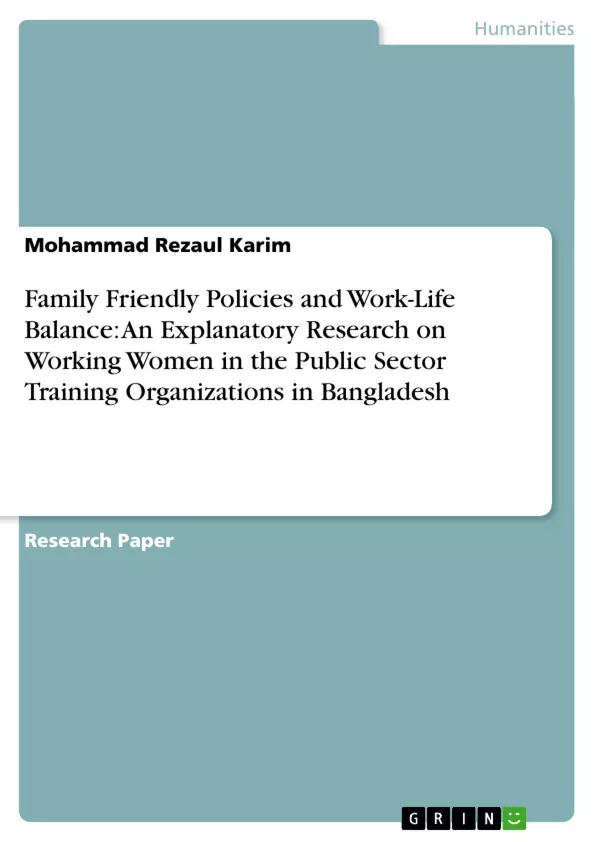The effects of globalisation on gendered division of labour, global market strategies, structural adjustment programmes, use of information technology and changing work organisation, working conditions are changed in different formats and there has been an increase of female participation in employment This change becomes more significant especially for the involvement of female workers at the workplace with a great responsibility at home for family activities. Like their male counterparts women are also earners for their families. However, they have to maintain their family activities such as caring young children, looking after ageing and disabled people that seems women have to do more than their men peers. Having realized this fact, family-friendly policies have been enacted and practised in the organization on the basis of recommendations of policy makers, researchers with an intention to utilize the women capital and play an important role in uplifting living conditions of women. These FFPs serve as the balancing between work and family live. These issues are considered as the benefit for working women with or without children who enjoy the advantage to utilise their time for family responsibilities As these are the concerns, the issue of quality of life has become a new aspect for the increase of female participation in labour force . Bangladesh is waved by the globalisation, internationalisation, pressure of donor agencies and recent change in the growth of female employment. This research has been framed to examine the causal relations between the family friendly policies and working life of women in the public sector training organizations.The population size comprises of all working women of these organizations. The study population (502) is the aggregation of elements from which the sample is selected. The Sample size selected from two strata i.e. managerial level and non-managerial (support staff) level employees are 156 and 249 respectively that calculated using the formula. This is a quantitative research where Family-friendly policies are the independent variables and working life of working women is the dependent variable. Hypotheses taken relating to the independent and dependent variables will be tested using the various statistical methods. The unit of analysis of this study is working women employed in the public sector training organizations. After getting data from the respondents, data will be analyzed using SPSS.
Inhaltsverzeichnis (Table of Contents)
- Introduction, Research Questions, Objectives and Significance of the Research
- Introduction
- Research Questions
- Objectives of the Research
- Problem Statement/Significance of the Study
- Women and FFPs in Public Sector Training Organizations
- Literature Review and Conceptual Framework
- Literature Review
- Training Organizations in Bangladesh
- Family-friendly policies
- Work-Life Balance
- Working culture
- Conceptual Framework and Key Variables
- Government initiatives, organizational practices and working women
- Relation between dependant and independent variables
- Variables and Indicators
- Operational definition of concepts used
- Hypotheses
- Research Design
- Population and Sampling Frame
- Sampling Frame
- Unit of Analysis and Measurement
- Data Collection Methods
- Analysis of Data
- Schedule
- Budget of the Research
- Limitations of the study
- Bibliography
- Questionnaire
Zielsetzung und Themenschwerpunkte (Objectives and Key Themes)
This research aims to examine the causal relationship between family-friendly policies and the work-life balance of women employed in public sector training organizations in Bangladesh. The study intends to contribute to the understanding of how family-friendly policies impact the working lives of women within these organizations and to identify potential areas for improvement.
- The impact of globalization on the changing roles of women in the workplace.
- The effectiveness of family-friendly policies in promoting work-life balance for women.
- The challenges and opportunities faced by working women in balancing family and work responsibilities.
- The influence of government initiatives, organizational practices, and work culture on women's work-life balance.
- The potential of family-friendly policies to empower women in the workplace and contribute to their economic and social well-being.
Zusammenfassung der Kapitel (Chapter Summaries)
The research begins with an introduction that lays out the context of the study and its significance. This section defines the research questions, objectives, and problem statement. The second chapter delves into a comprehensive literature review exploring existing research on training organizations in Bangladesh, family-friendly policies, work-life balance, and the working culture within these organizations. This chapter establishes the conceptual framework and key variables that will be explored throughout the study. The third chapter outlines the research design, including population, sampling frame, unit of analysis, data collection methods, and data analysis techniques. The chapter also addresses the schedule and budget for the research project. Finally, the study concludes with a discussion of potential limitations. This section discusses the potential for bias and limitations in the scope of the research.
Schlüsselwörter (Keywords)
The research focuses on family-friendly policies, work-life balance, working women, public sector training organizations, Bangladesh, globalization, government initiatives, organizational practices, working culture, and empirical research methods. The study uses quantitative research methodologies to analyze the relationships between these key variables and to test hypotheses about their impact on the working lives of women in these organizations. The study also explores themes of gender equality, empowerment, and social well-being.
- Quote paper
- Mohammad Rezaul Karim (Author), 2013, Family Friendly Policies and Work-Life Balance: An Explanatory Research on Working Women in the Public Sector Training Organizations in Bangladesh, Munich, GRIN Verlag, https://www.grin.com/document/213196



